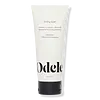What's inside
What's inside
 Key Ingredients
Key Ingredients

No key ingredients
 Benefits
Benefits

 Concerns
Concerns

 Ingredients Side-by-side
Ingredients Side-by-side

Water
Skin ConditioningRicinus Communis Seed Oil
MaskingDicaprylyl Carbonate
EmollientCetearyl Alcohol
EmollientOrbignya Speciosa Kernel Oil
EmollientBehentrimonium Chloride
PreservativeSodium Hyaluronate
HumectantAstrocaryum Murumuru Seed Butter
EmollientSimmondsia Chinensis Seed Oil
EmollientButyrospermum Parkii Butter
Skin ConditioningHylocereus Undatus Fruit Extract
Skin ConditioningPaullinia Cupana Seed Extract
Skin ConditioningUrtica Dioica Leaf Extract
Skin ConditioningZingiber Officinale Root Extract
MaskingPolyquaternium-10
Panthenol
Skin ConditioningGuar Hydroxypropyltrimonium Chloride
Skin ConditioningTocopherol
AntioxidantDisodium EDTA
Ethylhexylglycerin
Skin ConditioningGlycerin
HumectantCitric Acid
BufferingSodium Hydroxide
BufferingPotassium Sorbate
PreservativeSodium Benzoate
MaskingPhenoxyethanol
PreservativeParfum
MaskingLinalool
PerfumingLimonene
PerfumingCitronellol
PerfumingWater, Ricinus Communis Seed Oil, Dicaprylyl Carbonate, Cetearyl Alcohol, Orbignya Speciosa Kernel Oil, Behentrimonium Chloride, Sodium Hyaluronate, Astrocaryum Murumuru Seed Butter, Simmondsia Chinensis Seed Oil, Butyrospermum Parkii Butter, Hylocereus Undatus Fruit Extract, Paullinia Cupana Seed Extract, Urtica Dioica Leaf Extract, Zingiber Officinale Root Extract, Polyquaternium-10, Panthenol, Guar Hydroxypropyltrimonium Chloride, Tocopherol, Disodium EDTA, Ethylhexylglycerin, Glycerin, Citric Acid, Sodium Hydroxide, Potassium Sorbate, Sodium Benzoate, Phenoxyethanol, Parfum, Linalool, Limonene, Citronellol
Water
Skin ConditioningPropanediol
SolventPolysorbate 20
EmulsifyingHydroxyethylcellulose
Emulsion StabilisingLinoleamidopropyl Pg-Dimonium Chloride Phosphate Dimethicone
Water, Propanediol, Polysorbate 20, Hydroxyethylcellulose, Linoleamidopropyl Pg-Dimonium Chloride Phosphate Dimethicone, Amaranthus Caudatus Seed Extract, Hydrolyzed Rice Protein, Polyquaternium-10, Pvp, Maltodextrin/Vp Copolymer, Ethylhexylglycerin, Citric Acid, Sodium Hydroxide, Phenoxyethanol, Parfum
 Reviews
Reviews

Ingredients Explained
These ingredients are found in both products.
Ingredients higher up in an ingredient list are typically present in a larger amount.
Citric Acid is an alpha hydroxy acid (AHA) naturally found in citrus fruits like oranges, lemons, and limes.
Like other AHAs, citric acid can exfoliate skin by breaking down the bonds that hold dead skin cells together. This helps reveal smoother and brighter skin underneath.
However, this exfoliating effect only happens at high concentrations (20%) which can be hard to find in cosmetic products.
Due to this, citric acid is usually included in small amounts as a pH adjuster. This helps keep products slightly more acidic and compatible with skin's natural pH.
In skincare formulas, citric acid can:
While it can provide some skin benefits, research shows lactic acid and glycolic acid are generally more effective and less irritating exfoliants.
Most citric acid used in skincare today is made by fermenting sugars (usually from molasses). This synthetic version is identical to the natural citrus form but easier to stabilize and use in formulations.
Read more about some other popular AHA's here:
Learn more about Citric AcidEthylhexylglycerin (we can't pronounce this either) is commonly used as a preservative and skin softener. It is derived from glyceryl.
You might see Ethylhexylglycerin often paired with other preservatives such as phenoxyethanol. Ethylhexylglycerin has been found to increase the effectiveness of these other preservatives.
Parfum is a catch-all term for an ingredient or more that is used to give a scent to products.
Also called "fragrance", this ingredient can be a blend of hundreds of chemicals or plant oils. This means every product with "fragrance" or "parfum" in the ingredients list is a different mixture.
For instance, Habanolide is a proprietary trade name for a specific aroma chemical. When used as a fragrance ingredient in cosmetics, most aroma chemicals fall under the broad labeling category of “FRAGRANCE” or “PARFUM” according to EU and US regulations.
The term 'parfum' or 'fragrance' is not regulated in many countries. In many cases, it is up to the brand to define this term.
For instance, many brands choose to label themselves as "fragrance-free" because they are not using synthetic fragrances. However, their products may still contain ingredients such as essential oils that are considered a fragrance by INCI standards.
One example is Calendula flower extract. Calendula is an essential oil that still imparts a scent or 'fragrance'.
Depending on the blend, the ingredients in the mixture can cause allergies and sensitivities on the skin. Some ingredients that are known EU allergens include linalool and citronellol.
Parfum can also be used to mask or cover an unpleasant scent.
The bottom line is: not all fragrances/parfum/ingredients are created equally. If you are worried about fragrances, we recommend taking a closer look at an ingredient. And of course, we always recommend speaking with a professional.
Learn more about ParfumPhenoxyethanol is a preservative that has germicide, antimicrobial, and aromatic properties. Studies show that phenoxyethanol can prevent microbial growth. By itself, it has a scent that is similar to that of a rose.
It's often used in formulations along with Caprylyl Glycol to preserve the shelf life of products.
Polyquaternium-10 is an ammonium salt of hydroxyethylcellulose. It is a white and granular powder used as a film-former and anti-static agent.
This ingredient is commonly found in hair conditioning products. According to a manufacturer, its positive charge makes it great for absorbing hair proteins. The manufacturer also states this ingredient helps with curl retention.
For haircare friends: this ingredient is not a silicone.
Learn more about Polyquaternium-10Sodium Hydroxide is also known as lye or caustic soda. It is used to adjust the pH of products; many ingredients require a specific pH to be effective.
In small amounts, sodium hydroxide is considered safe to use. However, large amounts may cause chemical burns due to its high alkaline.
Your skin has a natural pH and acid mantle. This acid mantle helps prevent harmful bacteria from breaking through. The acid mantle also helps keep your skin hydrated.
"Alkaline" refers to a high pH level. A low pH level would be considered acidic.
Learn more about Sodium HydroxideWater. It's the most common cosmetic ingredient of all. You'll usually see it at the top of ingredient lists, meaning that it makes up the largest part of the product.
So why is it so popular? Water most often acts as a solvent - this means that it helps dissolve other ingredients into the formulation.
You'll also recognize water as that liquid we all need to stay alive. If you see this, drink a glass of water. Stay hydrated!
Learn more about Water